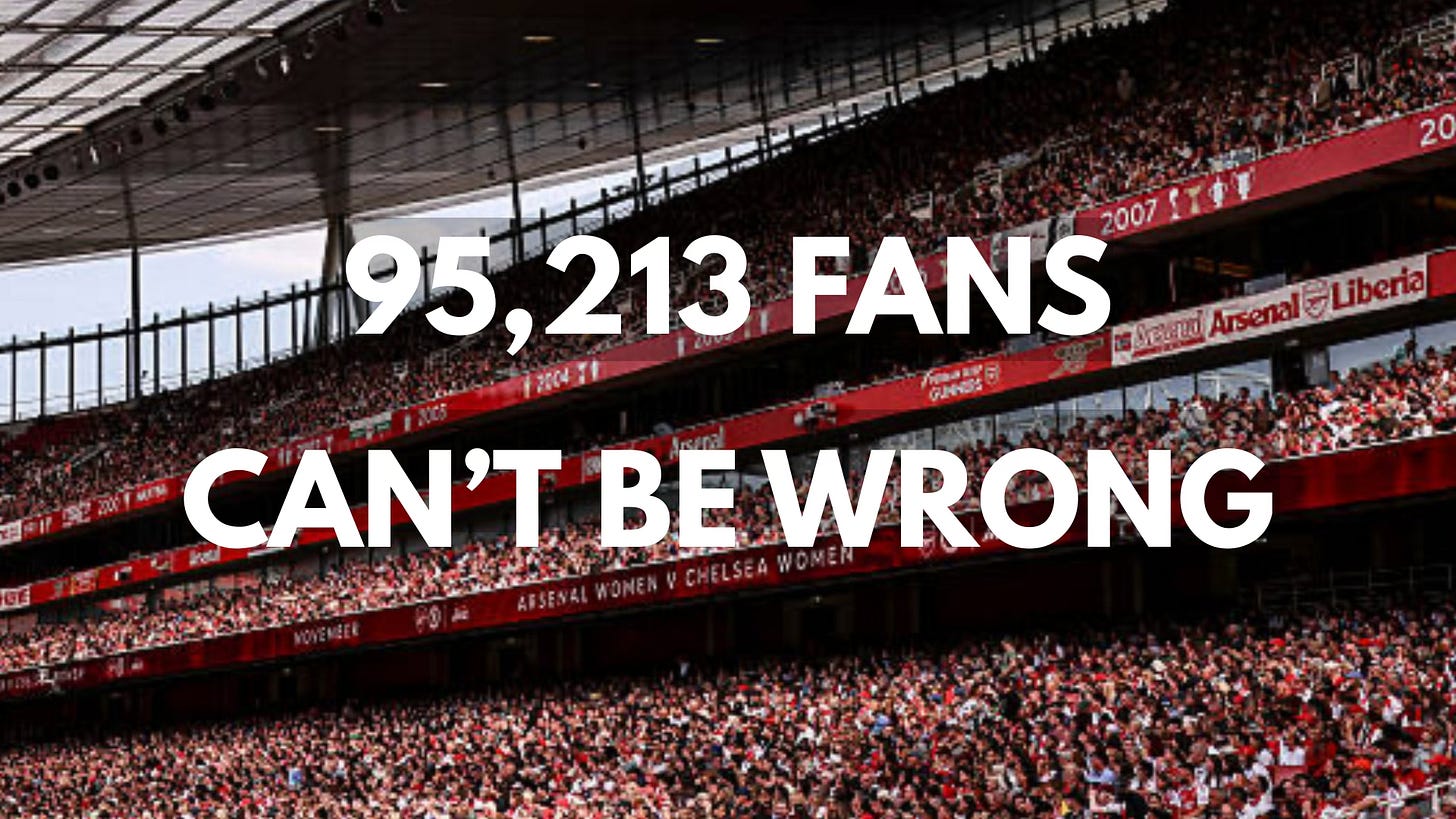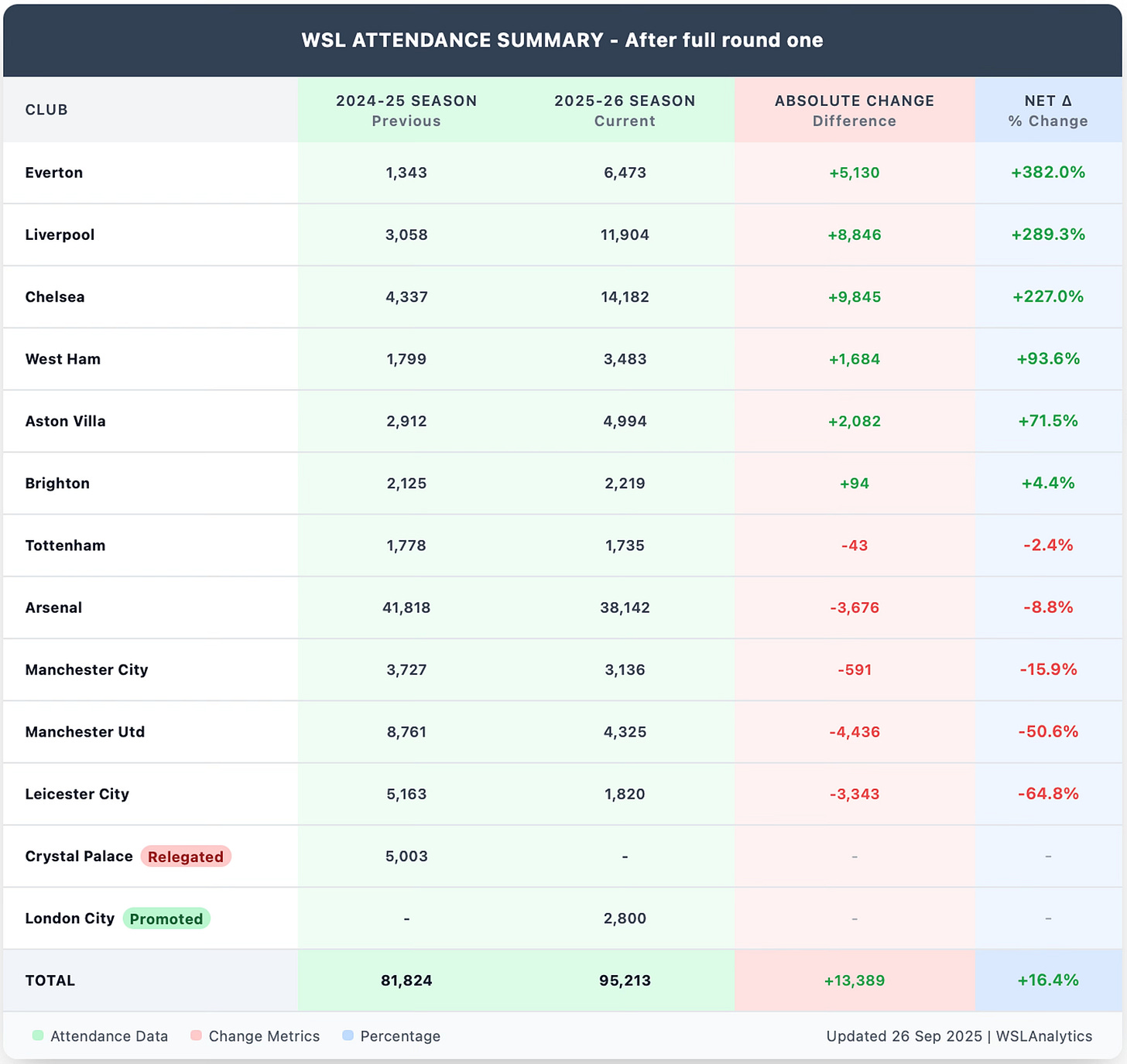WSL 2025–26 Round 1 Attendance Analysis: A Strong Rebound Signals League’s Renewed Appeal
Round 1 drew 95,213 fans (+16.4% YoY). Bigger venues & better promotion drove gains—momentum is back, even if it’s not a record. Club-by-club takeaways inside.
Overview
The opening round of the 2025-26 Barclays Women’s Super League (WSL) saw a significant uptick in fan turnout compared to the previous season’s opener. In total, 95,213 spectators attended Round 1 matches this season, up from 81,824 in 2024-25 – an increase of about 16.4%. This equates to roughly 7,934 per match on average (across 12 fixtures), compared to about 6,818 per match a year ago.
Such growth is notable, especially given that overall WSL attendances had actually dipped by ~10% in 2024-25 versus the prior year (averaging 6,661 per game vs 7,371 in 2023-24). The Round 1 figures for 2025-26 suggest a rebound in spectator interest, likely driven by strategic scheduling and clubs leveraging bigger venues to kick off the new season.
Several clubs scheduled their opening fixtures at larger stadiums and heavily promoted these matches. League officials had also adjusted match scheduling, a supposed attempt to boost turnout – for example, introducing a regular Sunday noon TV slot and removing Sunday evening kickoffs. These efforts appear to have paid immediate dividends in Round 1, with crowds flocking in greater numbers than the previous year’s opening weekend.
Club-by-Club Attendance Breakdown
Breaking down the attendance by club reveals a mixed but mostly positive picture, with some teams enjoying massive gains and a few experiencing declines. Notably, 6 out of the 11 returning WSL clubs (excluding the promoted/relegated sides) improved their Round 1 home crowds year-on-year.
The Big Winners
Arsenal: Still Leading the Pack
Arsenal Women continued to lead the league in fan support, drawing 38,142 to the Emirates for their opening match — the largest crowd of the round. That’s down from 41,818 at the 2024–25 opener (–8.8%), but still an enormous figure that dwarfs other clubs. The dip likely reflects the opponent context — newly promoted London City Lionesses don’t carry the same draw as last year’s marquee Manchester City fixture. Nevertheless, Arsenal’s commitment to playing all WSL home games at the Emirates this season is setting a high benchmark for attendance.
Chelsea: Stamford Bridge Effect
The defending champions saw a year-on-year opener lift: 14,182 attended Round 1 in 2025–26, up from 4,337at last season’s opener (+227%). Context: the equivalent Stamford Bridge fixture last season (vs Manchester City) drew 19,499, so this year’s crowd was ~27% lower than that Bridge benchmark—even though the opener-to-opener comparison shows clear growth.
Liverpool: Anfield Magic
Liverpool delivered one of Round 1’s biggest lifts: 11,904 versus 3,058 in last season’s opener (+289%). The jump coincides with moving the opener to Anfield (last year’s was at Totally Wicked Stadium). Context: compared to the equivalent Merseyside derby last season (15,376 vs Everton at Totally Wicked), this year’s Anfield turnout was ~23% lower.
Everton: The Biggest Percentage Gain
Everton — Everton posted the weekend’s biggest percentage jump, rising from 1,343 in last season’s opener to 6,473 in 2025–26 (+382%). The key change: Everton Women have made Goodison Park their permanent home for 2025–26, replacing Walton Hall Park (≈2,000 capacity). The move immediately paid off, with more than 5,000 additional supporters through the gates for the opener.
Solid Growth Stories
Aston Villa
Villa’s opener attendance rose from 2,912 last season to 4,994 in 2025–26 (+71.5%). This isn’t a venue effect: Villa played all home matches at Villa Park last season as well. For a like-for-like check, the equivalent Villa Park meeting with Chelsea last season drew 4,324, so this year’s turnout is about +15.5% higher. Solid growth for the Midlands fanbase—even without a stadium change narrative.
West Ham United
West Ham nearly doubled their opener attendance, from 1,799 last season to 3,483 in 2025–26 (+93.6%). For context, the equivalent fixture last season (vs Arsenal) drew 3,300, West Ham’s 2024–25 high, so this year’s turnout is ~5.5% higher. A clear step forward in East London without relying on a venue switch.
Flat or Declining
Brighton & Hove Albion
Brighton held steady year-on-year: 2,219 this season vs 2,125 last season’s opener (+4.4%). There was no venue change — the match was at Broadfield Stadium. For a like-for-like check, the equivalent fixture last season (vs Aston Villa) drew 2,152, so this year is about +3.1% higher. A modest uptick that keeps Brighton in the low-2k range without a big-venue or major marketing push.
Tottenham Hotspur
Spurs saw a marginal year-on-year dip: 1,735 vs 1,778 last season (–2.4%). There was no venue change, so no big-stadium uplift. For context, the equivalent home fixture last season (vs West Ham) drew 2,216, making this year –21.7% lower (–481 fans). It was the lowest attendance of the round, highlighting clear upside if Spurs schedule select games at Tottenham Hotspur Stadium and pair them with a stronger matchday push.
Manchester City
City’s opener dipped from 3,727 last season to 3,136 in 2025–26 (–15.9%, –591 fans). This is a like-for-like comparison: same opponent (Brighton) at the Joie Stadium (≈7,000 capacity) both seasons. No venue or opponent effects to explain it—just a softer turnout. Relative to the league trend of big-venue bumps elsewhere, City have clear room to grow with stronger marketing and a selective move to larger stages for marquee dates.
Manchester United: Biggest Drop
United’s Round 1 attendance fell from 8,761 last season to 4,325 in 2025–26 (–50.6%). The drop is venue-driven: last year’s opener was staged at Old Trafford, while this season’s was at Leigh Sports Village. Context: on a like-for-like basis at LSV, the equivalent fixture last season (vs Leicester City) drew 3,950, so this year’s 4,325 is actually ~+9.5%higher. Headline YoY looks harsh because of Old Trafford’s one-off bump; underlying LSV demand nudged up.
Leicester City
Leicester City — Leicester’s opener fell from 5,163 last season to 1,820 in 2025–26 (–64.8%). There was no venue change: both openers were at the King Power Stadium. For a like-for-like read, the equivalent home fixture last season (vs Liverpool) drew 2,964, so this year’s turnout is ~38.6% lower (–1,144 fans). Last season’s opener benefited from being a marquee fixture against Arsenal, whose following travels well.
Newcomers & Exits
London City Lionesses
The league welcomed London City Lionesses in 2025–26, replacing relegated Crystal Palace. London City’s WSL debut home match drew 2,800 — a respectable start for a newcomer building its top-flight fanbase. By comparison, Palace’s first WSL opener last season attracted 5,003 (boosted by staging it at Selhurst Park). Despite Palace’s exit, the overall Round 1 total still rose, as bigger venues and strong turnouts elsewhere more than offset the newcomer baseline. It will be interesting to watch how London City builds its attendance over the season, given they are based in the football-saturated London market.
The Venue and Marketing Impact
The Round 1 attendance trends underscore the critical impact of venue choice and marketing on crowd sizes in women’s football. A clear pattern emerges: fixtures held at major stadiums drew the largest crowds, often exponentially higher than games at smaller grounds.
The Contrast
Clubs that didn’t move to marquee venues generally saw smaller crowds:
Tottenham remained at secondary stadium: under 2,000 (lowest of weekend)
Brighton and Man City stayed at regular venues: little change around 2-3k mark
Looking Forward: Challenges and Opportunities
The Gap Remains
While the overall trend is positive, data reveals a significant gap between top and bottom:
Top tier: Arsenal, Chelsea, Liverpool regularly push five-figure crowds
Middle tier: Several clubs in 3-6k range with growth potential
Bottom tier: Some still hover around 1-2k
Key Lessons
Big venues work: Major stadiums can 3-4x typical attendance
Marketing matters: Promotion and media buzz amplify venue effects
Consistency challenge: Converting one-off spikes into regular support
Scheduling impact: TV-friendly slots boost overall interest
The Path Forward
Maintaining this upward trend will require:
More frequent use of bigger venues
Smarter scheduling building on TV slot success
Enhanced fan engagement to convert curiosity into loyalty
Better marketing of star players and storylines
Conclusion: A Promising Start
After Round 1 of 2025–26, the WSL’s attendance trajectory looks encouraging. The league drew 95,213 in total, up from 81,824 last season — a +16.4% rise. Multiple clubs posted gains, though growth wasn’t universal.
The data shows both potential and challenge. When major venues are used (Arsenal, Chelsea, Liverpool), five-figure gates are increasingly common. Elsewhere, progress depends more on opponent pull, scheduling, marketing, and pricing.
The lowest-attended fixture (1,735) is a useful reminder that growth isn’t automatic or evenly distributed. Even so, the aggregate uplift and several club-level success stories suggest the WSL is moving in the right direction.
If clubs continue to combine big-stage dates with smart promotion, we should see more sell-outs and periodic records across the season — consolidating the WSL’s status as one of the world’s fastest-growing leagues.
Sources: Club attendance reports (matchday summaries & post-match notes)
If this breakdown was useful, please subscribe and share — and join the conversation on X (Twitter) @WSLAnalytics for live WSL insights all weekend.




I don't understand how you arrived at your conclusions. My analysis shows the numbers are falling when comparing like for like fixtures. The opening fixture, Chelsea v Man City at Stamford Bridge, drew 14,182 fans. The same fixture last season attracted 19,499. That’s a 27% drop.
Arsenal v Aston Villa at the Emirates fell from 35,829 in 23/24, to 29,551 last season, and then to 24,712 last weekend. That’s a 31% drop in two years.
Across the 20 games in the WSL for which I have the data, 14 of them have seen attendances fall versus the equivalent fixture last season and the season before.